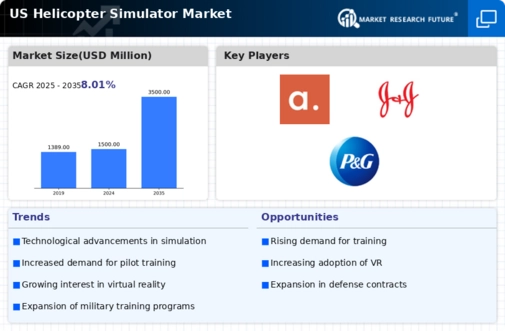The helicopter simulator market exhibits a dynamic competitive landscape characterized by rapid technological advancements and a growing emphasis on training efficiency. Key players such as CAE Inc (US), FlightSafety International (US), and L3Harris Technologies (US) are at the forefront, leveraging innovation and strategic partnerships to enhance their market positions. CAE Inc (US) focuses on integrating advanced simulation technologies, while FlightSafety International (US) emphasizes comprehensive training solutions tailored to diverse customer needs. L3Harris Technologies (US) appears to be concentrating on digital transformation initiatives, which may enhance operational efficiencies and customer engagement. Collectively, these strategies contribute to a competitive environment that prioritizes technological sophistication and customer-centric solutions.
In terms of business tactics, companies are increasingly localizing manufacturing and optimizing supply chains to enhance responsiveness to market demands. The competitive structure of the helicopter simulator market is moderately fragmented, with several key players exerting influence over various segments. This fragmentation allows for niche players to thrive, while larger companies leverage their resources to capture significant market shares. The collective influence of these key players shapes the market dynamics, fostering an environment where innovation and strategic collaborations are paramount.
In November 2025, CAE Inc (US) announced a partnership with a leading aerospace manufacturer to develop next-generation helicopter simulators. This collaboration is expected to enhance simulation fidelity and training effectiveness, positioning CAE as a leader in advanced training solutions. The strategic importance of this partnership lies in its potential to set new benchmarks in simulation technology, thereby attracting a broader customer base.
In October 2025, FlightSafety International (US) unveiled a new training program that incorporates virtual reality (VR) elements into its helicopter simulator offerings. This initiative aims to provide immersive training experiences, which could significantly improve pilot preparedness and operational safety. The introduction of VR technology reflects a broader trend towards integrating cutting-edge technologies into training methodologies, potentially reshaping industry standards.
In September 2025, L3Harris Technologies (US) launched an AI-driven analytics platform designed to optimize training outcomes for helicopter pilots. This platform utilizes data analytics to tailor training programs to individual pilot needs, thereby enhancing learning efficiency. The strategic significance of this development lies in its alignment with the growing trend of data-driven decision-making in training environments, which may lead to improved pilot performance and safety.
As of December 2025, the helicopter simulator market is increasingly defined by trends such as digitalization, sustainability, and AI integration. Strategic alliances among key players are shaping the competitive landscape, fostering innovation and collaborative advancements. Looking ahead, competitive differentiation is likely to evolve from traditional price-based competition towards a focus on innovation, technological integration, and supply chain reliability. This shift underscores the importance of adaptability and forward-thinking strategies in maintaining a competitive edge in the market.














Leave a Comment